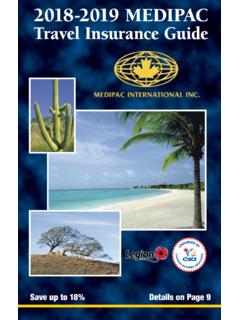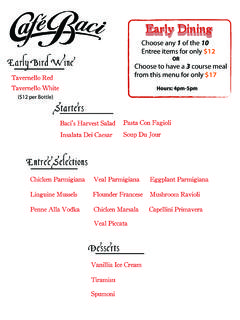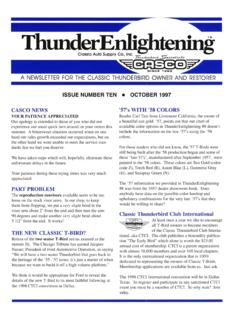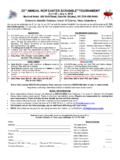Transcription of The - New York City Audubon
1 The Birds of Central ParkThis checklist includes the 200 species of wild birds regularlyseen in the Park since 1886. Eighty-one rare or historicalspecies are listed separately at the end. Typography is used to indicate status. Bolddenotes birdsthat are more commonly seen or heard in the appropriatehabitat and season, whether they are present YEAR-ROUNDor are Annual Migrants. (Many migrants are common foronly a few weeks each year.) Boldcan reflect either abundance (House Sparrow) or conspicuousness (MuteSwan). Infrequentspecies are seen only every few years. For example:BLUE JAYYear-round; more commonAMERICAN KESTRELYear-round; less commonBaltimore OrioleAnnual migrant; more commonHooded WarblerAnnual migrant; less commonMarsh WrenInfrequentUnless otherwise noted, migrants are seen in the Park whileon their way to breeding or wintering grounds.
2 For somespecies, spring migration begins as early as February; forothers, fall migration begins in July. Many owls, ducks, andsparrows occur primarily in winter. Flyoversare rarelyfound in the Park itself. The species order follows that of the 7th edition of the American Ornithologists Union Check list (1998).LOONS, GREBES, CORMORANTSRed-throated LoonFlyoverCommon LoonMainly flyoverPied-billed GrebeDouble-crested CormorantOcc. wintersBITTERNS, HERONS, IBISESA merican BitternGREAT BLUE HERONG reat EgretSnowy EgretGreen HeronHas nestedBlack-crowned Night-HeronOft. wintersVULTURESB lack VultureFlyoverTurkey VultureFlyoverWATERFOWLSnow GooseMainly flyoverCANADA GOOSEB rantMainly flyoverMUTE SWANN estsWood DuckA few winterGadwallAmerican WigeonAmerican Black DuckWintersMALLARDN estsNorthern ShovelerNorthern PintailGreen-winged TealCanvasbackRing-necked DuckYEAR-ROUND Annual Migrant InfrequentCommon/ Less Common TheBirdsAn Annotated Checklistof Central ScaupSolitary SandpiperSpotted SandpiperLeast SandpiperCommon SnipeAmerican WoodcockGULLSL aughing GullDaily summer visitorRING-BILLED GULLHERRING GULLI celand GullGREAT BLACK-BACKED GULLDOVES, CUCKOOSROCK DOVE(pigeon)
3 NestsMOURNING DOVEN estsBlack-billed CuckooYellow-billed CuckooOWLSEASTERN SCREECH-OWLR eintroduced in 1998 Great Horned OwlLong-eared OwlOft. wintersNorthern Saw-whet OwlGOATSUCKERSC ommon NighthawkChuck-will s-widowWhip-poor-willSWIFTS, HUMMINGBIRDS, KINGFISHERSC himney SwiftDaily summer flyoverRuby-throated HummingbirdWOODPECKERSRed-headed WoodpeckerOft. wintersRED-BELLIED WOODPECKERN estsYellow-bellied SapsuckerOcc. wintersDOWNY WOODPECKERN estsHairy WoodpeckerOcc. wintersNorthern(Yellow-shafted)FlickerNe sts; occ. wintersFLYCATCHERSO live-sided FlycatcherEastern Wood PeweeYellow-bellied FlycatcherAcadian FlycatcherAlder FlycatcherWillow FlycatcherLeast FlycatcherEastern PhoebeGreat Crested FlycatcherEastern KingbirdNestsVIREOSW hite-eyed VireoYellow-throated VireoHas nestedBlue-headed (Solitary)VireoWarbling VireoOcc.
4 NestsPhiladelphia VireoMostly fallRed-eyed VireoOcc. nestsJAYS, CROWSBLUE JAYN estsAMERICAN CROWN estsFish CrowHas nestedYEAR-ROUND Annual Migrant InfrequentCommon/ Less CommonYEAR-ROUND Annual Migrant InfrequentCommon/ Less CommonYEAR-ROUND Annual Migrant InfrequentCommon/ Less Common ScaupLesser ScaupBuffleheadWintersHooded MerganserCommon MerganserRed-breasted MerganserRuddy DuckWintersBIRDS OF PREYO spreyFlyoverBald EagleFlyoverNorthern Harrier (Marsh Hawk)FlyoverSharp-shinned HawkFlyover; oft. in ParkCooper s HawkFlyover; occ. wintersNorthern GoshawkFlyover; infreq. in ParkRed-shouldered HawkFlyover; infreq. in ParkBroad-winged HawkFlyoverRED-TAILED HAWKN ests on Fifth HawkFlyoverGolden EagleFlyoverAMERICAN KESTRELN ests in NYCM erlinPEREGRINE FALCONN ests in NYCPHEASANTSRING-NECKED PHEASANTHas nestedGALLINULES, COOTSC ommon MoorhenAmerican CootOft.
5 WintersSHOREBIRDSK illdeerHas nestedGreater Yellowlegs American RobinNests; a few win-terMIMIC THRUSHESGray CatbirdNests; infreq. wintersNORTHERN MOCKINGBIRDN estsBrown ThrasherHas nested; occ. wintersSTARLINGS, WAXWINGSEUROPEAN STARLINGN estsCedar WaxwingOcc. nestsWOOD-WARBLERSBlue-winged WarblerGolden-winged WarblerLawrence s Warbler (BW & GW hybrid)Brewster s Warbler (BW & GW hybrid)Tennessee WarblerOrange-crowned WarblerNashville WarblerNorthern ParulaYellow WarblerChestnut-sided WarblerMagnolia WarblerCape May WarblerBlack-throated Blue WarblerYellow-rumped (Myrtle)WarblerBlack-throated Green WarblerBlackburnian WarblerYellow-throated WarblerMostly springPine WarblerPrairie ScaupPalm WarblerBay-breasted WarblerBlackpoll WarblerCerulean WarblerMostly springBlack-and-white WarblerAmerican RedstartProthonotary WarblerMostly springWorm-eating WarblerOvenbirdNorthern WaterthrushLouisiana WaterthrushKentucky WarblerMostly springConnecticut WarblerMostly fallMourning WarblerCommon YellowthroatHooded WarblerWilson s WarblerCanada WarblerYellow-breasted ChatTANAGERSS ummer TanagerMostly springScarlet TanagerSPARROWSE astern(Rufous-sided)TowheeOcc.
6 WintersAmerican Tree SparrowMostly winterChipping SparrowField SparrowVesper SparrowSavannah SparrowYEAR-ROUND Annual Migrant InfrequentCommon/ Less CommonYEAR-ROUND Annual Migrant InfrequentCommon/ Less CommonYEAR-ROUND Annual Migrant InfrequentCommon/ Less Common SWALLOWS reater ScaupTree SwallowNorthern Rough-winged SwallowBank SwallowCliff SwallowBarn SwallowCHICKADEES, TITMICEB lack-capped ChickadeeHas nestedTUFTED TITMOUSEN estsNUTHATCHES, CREEPERSRed-breasted NuthatchOcc. wintersWhite-breasted NuthatchWintersBrown CreeperOcc. wintersWRENSC arolina WrenOcc. wintersHouse WrenNestsWinter WrenOcc. wintersMarsh WrenKINGLETS, GNATCATCHERSG olden-crowned KingletOcc.
7 WintersRuby-crowned KingletOcc. wintersBlue-gray GnatcatcherTHRUSHESE astern BluebirdVeeryGray-cheeked ThrushBicknell s ThrushSwainson s ThrushHermit ThrushOcc. wintersWood ThrushHas nested Help Protect Birds and Their Habitat When observing birds, stay on paved paths and Parkdrives. Trampling damages fragile vegetation. Observe birds from a comfortable distance. If a birdseems agitated by your presence, move farther away. Don t approach or try to rescue a fallen nestling. The parents are usually nearby and will continue to care for pick up litter and dispose of it properly. Birds can get entangled in discarded fishing line, six-pack loops, and plastic Park Conservancy is a private, not-for-profitorganization founded in 1980 that manages Central Parkunder a contract with the City of New York/Parks &Recreation.
8 The Conservancy invites all Central Park visitors to become partners in taking care of the Park toensure that it remains a beautiful place for leisure, recreation, and the appreciation of more information about the Conservancy, please call 212-310-6600 or visit our website at take a tour or to learn more about the Urban ParkRangers, please call list was compiled and designed by RebekahCreshkoff and Marie Winn, and reviewed by Tom Fiore,Dick Gershon, Roger Pasquier, Peter Post, Steve Quinn,Marty Sohmer, and Lloyd Spitalnik. Cover illustration by Ed brochure is made possible by a grant from theUris Brothers GrebeRed-necked GrebeAnhingaLeast BitternLittle Blue HeronTricolored HeronCattle Egret (Flyover)Yellow-crowned Night-HeronGlossy IbisEurasian WigeonBlue-winged TealRedheadTufted DuckCommon EiderSurf ScoterWhite-winged ScoterLong-tailed Duck (Oldsquaw)Common GoldeneyeMississippi KiteWild TurkeyVirginia RailSoraBlack-bellied PloverSemipalmated PloverLesser YellowlegsUpland SandpiperWhimbrel (Flyover)
9 Semipalmated SandpiperWhite-rumped SandpiperPectoral SandpiperRed PhalaropeBlack-headed GullBonaparte s GullLesser Black-backed GullGlaucous GullCaspian TernCommon TernForster s TernBlack SkimmerBarn OwlBarred OwlShort-eared OwlWestern KingbirdNorthern ShrikeBell s VireoHorned LarkPurple MartinBoreal ChickadeeNorthern WheatearAmerican PipitSwainson s WarblerWestern TanagerClay-colored SparrowLark SparrowGrasshopper SparrowHenslow s SparrowLeConte s SparrowSaltmarsh Sharp-tailed SparrowSeaside SparrowLapland LongspurSnow BuntingPainted BuntingDickcisselYellow-headed Blackbird Brewer s BlackbirdRed CrossbillWhite-winged CrossbillRARE(seen fewer than ten times since 1970)Ruffed GrouseNorthern BobwhiteClapper RailPurple GallinuleWestern SandpiperSnowy OwlBlack-backed WoodpeckerLoggerhead ShrikeBewick s WrenSedge WrenBlack-throated Gray WarblerTownsend s WarblerHISTORICAL(not seen since 1970) ScaupFox SparrowOft.
10 WintersSong SparrowNests; a few winterLincoln s SparrowSwamp SparrowOcc. wintersWhite-throated SparrowWintersWhite-crowned SparrowDark-eyed JuncoOcc. wintersNORTHERN CARDINALN estsRose-breasted GrosbeakBlue GrosbeakIndigo BuntingBLACKBIRDSB obolinkRed-winged BlackbirdNests; occ. wintersEastern MeadowlarkRusty BlackbirdCommon GrackleNestsBrown-headed CowbirdOcc. wintersOrchard OrioleMostly springBaltimore OrioleNestsFINCHES, OLD-WORLD SPARROWSP urple FinchHOUSE FINCHN estsCommon RedpollPine SiskinAmerican GoldfinchWintersEvening GrosbeakHOUSE SPARROWN ests YEAR-ROUND Annual Migrant InfrequentCommon/ Less Commo






